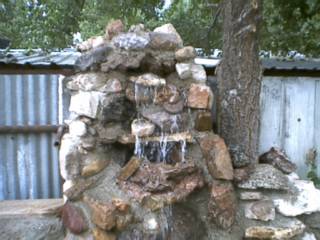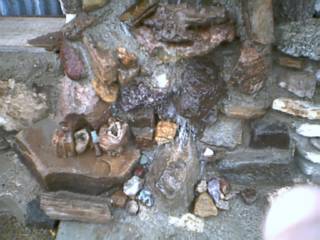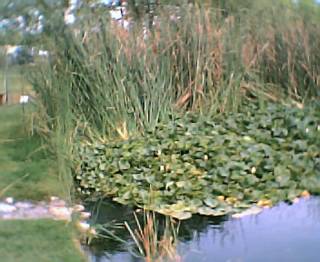I found this short but fairly informative page about the Llano Estacado, which supplements this second page found on the USGS site.
Anyone wanting more in-depth information should start with either of the following two links.
Handbook of Texas Online: LLANO ESTACADO
or
Sky and Mesa, and the Llano Estacado Bioregion
Tuesday, May 25, 2004
Sunday, May 23, 2004
05/23/04
4PM. I haven't been awake very long and this is my first time outside since I got in from work this morning. It is hot with a mild breeze. Although I have other things to do, I can see Bill working on the pond and it is like a magnet to me. He has just finished mowing the flat top of the berm and I have trimmed about 1/4 of the inner edge and outer bank using clippers and a weed-eater. My recent plantings have a few new leaves - I would guess a sign of life - but none of the seeds or bulb plants have surfaced. This is the best time, and the worst. Most of May and June will be manicure, trim and remove debris. The visual rewards are still a few months away, but then they last almost until Winter.
Last week a friend of Bill's brought a big mound of frog eggs which they placed in some reeds near the waterfall spill-way. Those were a bird feast within a few hours. This week he brought tadpoles, so, maybe. Bill has tried to introduce frogs into the pond for the past two years, but nothing yet. The year before last he placed two adult frogs (leopard?) in some reeds on the West bank, and we never saw them again. Occasionally as we are walking around the pond we will hear a splash as something hits the water in the reeds, and Bill thinks it is one of those frogs, but I once saw a snake drop into the water from the bank and it made the same sound.
About the local snakes - I don't actually even like the subject, but they are an element of this ecological situation.
There is a large variety of local snakes, mostly harmless to humans, but the one of concern to everyone is the rattlesnake. They are common here and I have seen them often throughout my life. And, although there are times when I am more cautious than others, (dense weeds, piles of rocks/boards/junk, old structures), they have never been a limiting factor. I have hiked and camped throughout the entire region without a lot of concern. The community where I live is a small collection of structures (less than 300) set in a large prairie. Snakes and all other wildlife pretty much pass through constantly. Every summer someone or several people will find a rattlesnake in the yard, in the garage or carport, or on one of the roads in town. We live on the Southeast edge of the community and there is an open pasture for miles beyond our yards. Snakes are just here and we are always watching for them, even if we aren't always aware that we are.
In the two years before he put the pond in, Bill lost two of his dogs to rattlesnakes. He also saw several others on his land. During that time I once found a Western whip snake in my kitchen, it apparently came in through the dog door, and a few days later found a rattlesnake outside my back door looking like it might be attempting to enter the dog door. I just removed the harmless snake, but killed the rattlesnake before I could even think about it.
It would seem that introducing a pond into an area where every animal is always searching for water would be asking for trouble with snakes. So far this isn't true. For the past three years a Grey Owl, what could be a pair of Kestrels, a Cooper's Hawk, and two ragged looking Roadrunners have lived in the trees beside the pond and hunt almost daily. Their predation is supplemented by a steady stream of other hunters passing through and munching on each other, all of which combines to makes us more "snake free" than we ever have been. The same general thing seems to have happened to the mosquitoes. Before the pond was here there seemed to be plenty around. Now there are so many birds hunting that they don't stand a chance.
Before total darkness I watered the new plants and checked the aeration system (we have to supplement the aeration process because the water-fall is a fill line, it doesn't recirculate).
Last week a friend of Bill's brought a big mound of frog eggs which they placed in some reeds near the waterfall spill-way. Those were a bird feast within a few hours. This week he brought tadpoles, so, maybe. Bill has tried to introduce frogs into the pond for the past two years, but nothing yet. The year before last he placed two adult frogs (leopard?) in some reeds on the West bank, and we never saw them again. Occasionally as we are walking around the pond we will hear a splash as something hits the water in the reeds, and Bill thinks it is one of those frogs, but I once saw a snake drop into the water from the bank and it made the same sound.
About the local snakes - I don't actually even like the subject, but they are an element of this ecological situation.
There is a large variety of local snakes, mostly harmless to humans, but the one of concern to everyone is the rattlesnake. They are common here and I have seen them often throughout my life. And, although there are times when I am more cautious than others, (dense weeds, piles of rocks/boards/junk, old structures), they have never been a limiting factor. I have hiked and camped throughout the entire region without a lot of concern. The community where I live is a small collection of structures (less than 300) set in a large prairie. Snakes and all other wildlife pretty much pass through constantly. Every summer someone or several people will find a rattlesnake in the yard, in the garage or carport, or on one of the roads in town. We live on the Southeast edge of the community and there is an open pasture for miles beyond our yards. Snakes are just here and we are always watching for them, even if we aren't always aware that we are.
In the two years before he put the pond in, Bill lost two of his dogs to rattlesnakes. He also saw several others on his land. During that time I once found a Western whip snake in my kitchen, it apparently came in through the dog door, and a few days later found a rattlesnake outside my back door looking like it might be attempting to enter the dog door. I just removed the harmless snake, but killed the rattlesnake before I could even think about it.
It would seem that introducing a pond into an area where every animal is always searching for water would be asking for trouble with snakes. So far this isn't true. For the past three years a Grey Owl, what could be a pair of Kestrels, a Cooper's Hawk, and two ragged looking Roadrunners have lived in the trees beside the pond and hunt almost daily. Their predation is supplemented by a steady stream of other hunters passing through and munching on each other, all of which combines to makes us more "snake free" than we ever have been. The same general thing seems to have happened to the mosquitoes. Before the pond was here there seemed to be plenty around. Now there are so many birds hunting that they don't stand a chance.
Before total darkness I watered the new plants and checked the aeration system (we have to supplement the aeration process because the water-fall is a fill line, it doesn't recirculate).
05/21/04
8PM and I'm sitting on the East side of the pond watching the sun set. No clouds for a really great light show, but still nice colors. It was still warm when I came outside about 30 minutes ago, but has cooled noticeably, and in a few minutes a cool, dry breeze will appear. This happens nearly every night during the hot months and is one of the reasons I prefer living in this area.
There is noticeable humidity and I can smell blooming plants (honeysuckle) nearby. The birds are very active, possibly because it rained 3/10 of an inch last night, which is different. For the past five years we have had less than 6" of effective precipitation per year, about half of the normal average, then this year we had over 3" in April, and over 1/2" so far this month. Even such a small amount of moisture will bring arid region plants and animals to life.
9PM, the sun is down, I'm watching for the last view of Venus along the Western horizon, and the cool breeze just came. It's such a surprisingly instantaneous phenomenon. The season changes here happen in the same way. To quote Ian Anderson, "Summer always comes in a day."
There is noticeable humidity and I can smell blooming plants (honeysuckle) nearby. The birds are very active, possibly because it rained 3/10 of an inch last night, which is different. For the past five years we have had less than 6" of effective precipitation per year, about half of the normal average, then this year we had over 3" in April, and over 1/2" so far this month. Even such a small amount of moisture will bring arid region plants and animals to life.
9PM, the sun is down, I'm watching for the last view of Venus along the Western horizon, and the cool breeze just came. It's such a surprisingly instantaneous phenomenon. The season changes here happen in the same way. To quote Ian Anderson, "Summer always comes in a day."
Friday, May 21, 2004
Llano Estacado
This is the view in any direction from outside of the town where I live. Some of my relatives (by marriage) were among the first settlers in the community during the early 1900's. They are dead now, but often referred to the early years when I was around them. The grasses were taller, and more dense in the beginning, and even during my lifetime we have occasionally had wet years when they would shoot up and spread out, but generally during the daytime for much of the year, the plains appear to be worn out. Green is rare. We really only have two seasons, and the primary colors in the landscape, grey (Winter), and brown (Summer), reflect that. The sky is where the colors are and most of the action takes place. Sunsets and Sunrises are stunning, and some of the storms are magnificient.
Up to Date
Although I realize that the quality of most of the photos that I have posted is not so good, for now, I am out of any kind, and up to date.
The last nest of a new generation of blackbirds hatched since yesterday.
I planted a Crepe Myrtle and an Azalea against the shop on the East side of the water fall this week. I really don't plant according to a plan, and probably should, but am generally lucky with things like that - the right plant in the right place. I also cleaned up the East side of the shop (which is in the walkway to the Northeast side of the pond) and made beds to plant things in. I planted orange and yellow cannas in one section and am thinking about putting vegetables in the rest of the space. For one thing, I crave having a garden, and for another, anything that is watered from the pond grows incredibly well.
The last nest of a new generation of blackbirds hatched since yesterday.
I planted a Crepe Myrtle and an Azalea against the shop on the East side of the water fall this week. I really don't plant according to a plan, and probably should, but am generally lucky with things like that - the right plant in the right place. I also cleaned up the East side of the shop (which is in the walkway to the Northeast side of the pond) and made beds to plant things in. I planted orange and yellow cannas in one section and am thinking about putting vegetables in the rest of the space. For one thing, I crave having a garden, and for another, anything that is watered from the pond grows incredibly well.
The Fourth Year: June 2003 - May 2004
The Fall was beautiful and my sister and I spent most of every afternoon either working on, or enjoying the place. One interesting thing, although hanging out near bodies of water seems to be the way to contract the West Nile Virus, there are few to no mosquitoes around Mr. Bill's Pond. The Catfish skim the water like whales every morning and the birds feast on whatever gets past them.
The water never really froze over this past Winter, and during the coldest times there were always ducks, two large white birds with long black bills, and the red-winged blackbirds. When it was the coldest and the birds were the least active I cleaned out a boat load of Cat Tails from the West end and we left the rest as shelter for them. By this Spring, there were at least 8 males in permanent residence and they have the pond divided in half, four on each side.
The water never really froze over this past Winter, and during the coldest times there were always ducks, two large white birds with long black bills, and the red-winged blackbirds. When it was the coldest and the birds were the least active I cleaned out a boat load of Cat Tails from the West end and we left the rest as shelter for them. By this Spring, there were at least 8 males in permanent residence and they have the pond divided in half, four on each side.
Back to the Beginning
A friend dropped by during my days off and happened to have a photo album with these pictures of the pond as we were finishing lining it. This was the hardest of the labor. It wore me out and ruined Bill's back, but that seems to have saved his marriage. The greenery seen in some of the background is composed of a few stunted elm trees that grow in what was once an irrigation ditch. My sister's grandson calls it "the forest", but it really isn't.
The Third Year: Continued
Although we had seen some evidence the previous year that the pond stressed during the late Summer we learned more about the life cycle in a pond and realized that at some times during the year we would need to supplement oxygenation of the water. I had been trying to get Bill to build a waterfall from the first day, and in May of 2003 he agreed. The metal building is on the North side of the pond, and his water well is on the North side of that. He had the pipe coming out of the well, over the roof of the metal building and hanging out over the pond. (Visible in some pictures, very little of the water was aerated.) Our original plan was very ambitious and involved rocking the entire side of the shop with the large white caliche rocks, then creating ledges into a sluce-way that would run into the pond. In the end that would have taken too long to complete so we used my rock collection and made a much smaller version. I have studied and been interested in Geology for most of my life, and all of the rocks in the water fall were collected during the past 30 years throughout the Western United States. We will eventually use plants to cover the rest of the building. We switched over completely to the water fall fill system by the end of May.
The Third Year: June 2002 - May 2003
The plant, catfish, and bird population exploded during the Summer and Fall of this year. To begin with, the group of red-winged blackbirds never left over the winter and created a considerable population by the Winter of 2002. They are tremendously productive little birds, and very agressive regarding their territory. Although they seem to be tolerant of visitors that leave quickly, they attack any other birds that try to stick around.
A variety of other animals started showing up, Cooper's Hawks, Red Foxes, two large Grey Owls, and the strangest of all, as Winter grew near, three young deer appeared. During the past 20 years white tail deer have migrated in this direction but this is the first time any have been seen in the town.
A variety of other animals started showing up, Cooper's Hawks, Red Foxes, two large Grey Owls, and the strangest of all, as Winter grew near, three young deer appeared. During the past 20 years white tail deer have migrated in this direction but this is the first time any have been seen in the town.
Subscribe to:
Comments (Atom)


























